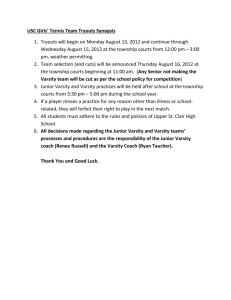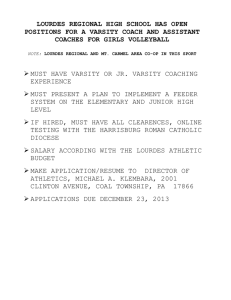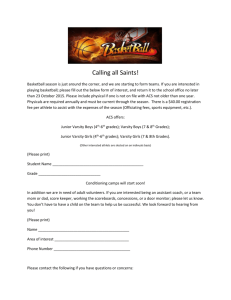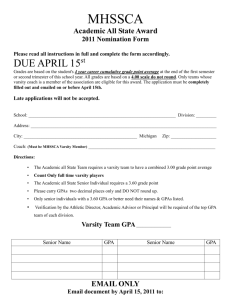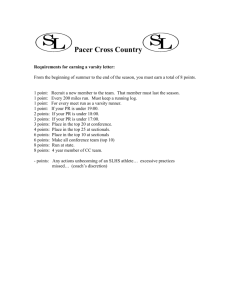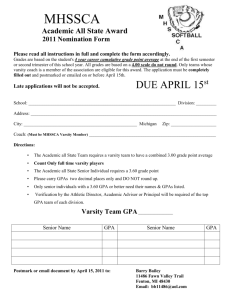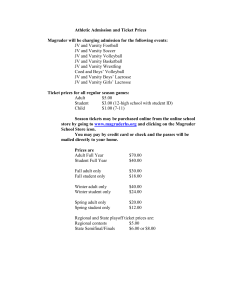File - MGT 611 with Professor Mehra
advertisement
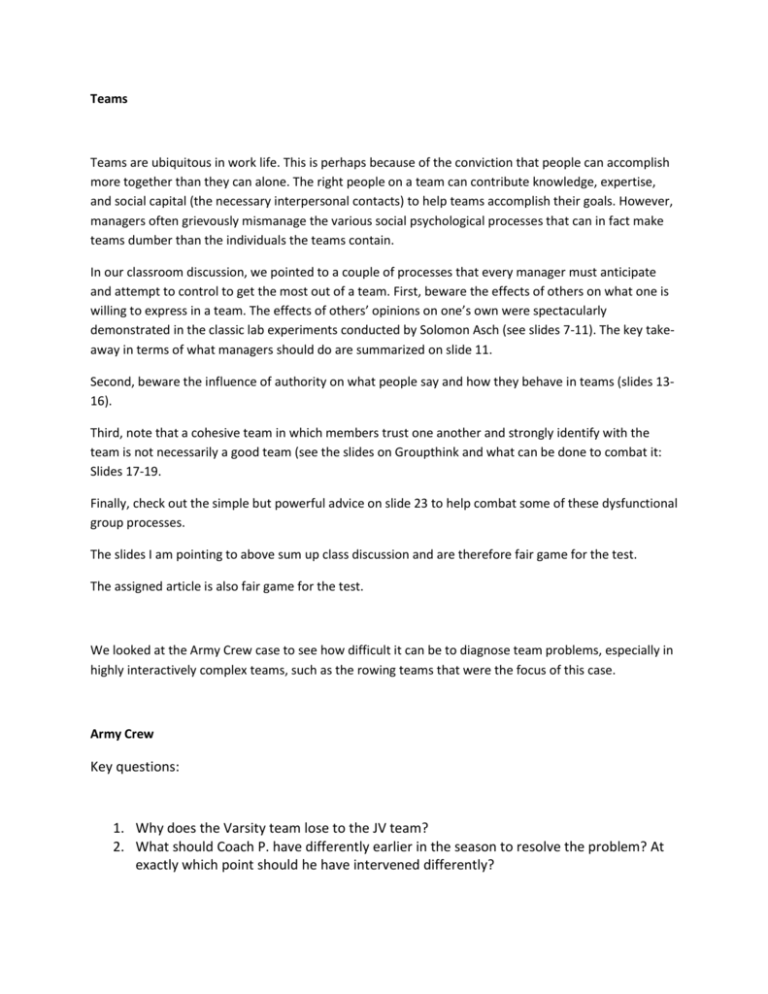
Teams Teams are ubiquitous in work life. This is perhaps because of the conviction that people can accomplish more together than they can alone. The right people on a team can contribute knowledge, expertise, and social capital (the necessary interpersonal contacts) to help teams accomplish their goals. However, managers often grievously mismanage the various social psychological processes that can in fact make teams dumber than the individuals the teams contain. In our classroom discussion, we pointed to a couple of processes that every manager must anticipate and attempt to control to get the most out of a team. First, beware the effects of others on what one is willing to express in a team. The effects of others’ opinions on one’s own were spectacularly demonstrated in the classic lab experiments conducted by Solomon Asch (see slides 7-11). The key takeaway in terms of what managers should do are summarized on slide 11. Second, beware the influence of authority on what people say and how they behave in teams (slides 1316). Third, note that a cohesive team in which members trust one another and strongly identify with the team is not necessarily a good team (see the slides on Groupthink and what can be done to combat it: Slides 17-19. Finally, check out the simple but powerful advice on slide 23 to help combat some of these dysfunctional group processes. The slides I am pointing to above sum up class discussion and are therefore fair game for the test. The assigned article is also fair game for the test. We looked at the Army Crew case to see how difficult it can be to diagnose team problems, especially in highly interactively complex teams, such as the rowing teams that were the focus of this case. Army Crew Key questions: 1. Why does the Varsity team lose to the JV team? 2. What should Coach P. have differently earlier in the season to resolve the problem? At exactly which point should he have intervened differently? 3. At the end of the case, what action should Coach P. take on Tuesday? Why do you recommend this action? How should he implement this action? Please be specific. 4. How would you compare Army Crew to other types of organizational teams? What are some key similarities/differences? What lessons can we learn from the Army Crew team? You Should Know the Specifics on… - When the problem started. What do terms like “team identity” and “team trust” really mean? What are performance-efficacy spirals? How to identify and arrest them. What’s wrong with Varsity? - Too much conflict Finger-pointing Poor leadership Lack of trust Low confidence Lack of team identity Conflict - - Need to distinguish affective/interpersonal conflict from task conflict. Affective conflict involves interpersonal tension, annoyance, frustration. Task conflict involves iussues of priorities, goals, alternatives, and task strategies (how to accomplish tasks). Moderate levels of task conflict can be good. What was the conflict in Varsity about? What issues troubled them? o Initially, task related difficulties focusing on individual mistakes (p.8 of case) o This lead to personality fiction: e.g., heated emails they sent to coach (p.7 of case) Is all conflict bad? No conflict could suggest suppression. (Remove affective overtones in emails?) If members blame the lack of technical coordination on personality clashes, task conflict can become affective conflict. What do you need to do as a leader to have the right atmosphere for raising issues of task conflict without it devolving into interpersonal conflict. Trust - Is especially important when individual contributions are difficult to monitor: if someone falls out of synch, the team cannot tell who it was, even if they feel the negative consequence; if the original out-of-synch rower does not recover on next stroke, entire team suffers. - - Why does trusting other rowers matter to the team task? o Pooled and reciprocal interdependence: provide maximum power but with constraint of having to stay in synch with the rest of the rowers: given specific level of combined rowing force, in-snych will go faster than out of synch o When work is interdependent, greater interpersonal coordination is required: like orchestras: little room for coordination error o Adjustments by other rowers likely to slow things down further rather than speeding things up: combined force is attenuated by lack of synchronization. There is a lack of trust between certain pairs of rowers Poor performance has eroded team trust: this is why Varsity team wins when they row in pairs or four person boats, but not when they row as an entire team. Taking one person from V and putting them in JV team does not significantly impact the performance of JV. Team Identification Conflict is a behavioral construct; trust is a psychological state. Team identity: knowledge of belonging + emotional significance of membership. Strong team identity => cohesion, loyalty, trust, cooperation, perceptions of efficacy. (But it can also have its drawbacks, as we will discuss) Where does team identity come from? (“we will succeed together, we will fail together vs. I never thought I’d be the weak link, but on this race I’m sure of it.”) - From Inter-team rivalry - From the tendency to categorize into “us” vs “them” - From performance/success: easier to identify with a winning team - Interpersonal attraction/trust/cohesion: when team members trust and like one another, easier to build a sense of team identity. Performance-Efficacy Spirals - In spirals, effective teams get better over time; ineffective ones get worse. - External attributions when performance is good; internal attributions when bad. What the team attributes its performance to can influence whether it gets stuck in a spiral or gets out of it. Blaming the team and its members only worsened prior performance and got Varsity locked in a performance-efficacy spiral. The worse they did, the more they lost confidence and blamed each other, the worse their subsequent performance was. -Performance Efficacy Attributions Performance Recommendations - Should Coach intervene at team level or talk to individuals? When should the coach have intervened? Right after first loss? Or after pattern emerged? Varsity didn’t get a chance to bond (Atlanta retreat both teams were together) Perhaps separate teams and allow for early wins: maybe have them row against clocks When was it too late to intervene? Switch teams? Switch rowers? Build up team trust and efficacy? Pep talk? Get teams to surface and talk about root problems? Get ‘em back on ERG machines to see who is individually stronger/weaker? What is the psychology behind your recommendation? How will the action influence varisty rowers? Will it increase/decrease team confidence, trust, identity? What assumptions are you making? What are the risks of your approach? This case is about the causes of differential team performance. I won’t try to summarize the case here—we did that in class. But let me touch on a few key points by way of emphasis. 1. The coach had collected extensive objective performance data for each individual to come up with the composition of the Varsity and Junior Varsity teams. He had his top eight rowers in Varsity; and yet Junior Varsity was consistently (about 2/3 of the time) beating Varsity in practice. The case is about how to figure out what may be behind these seemingly aberrant results; and how to do something practical, given the short amount of time the coach had on hand before the national race. Keep in mind: the nature of the team task in this case was highly interactive: the mistakes of any one individual influenced the entire team’s performance. Also, the task required a high degree of trust among team members: in the absence of trust, the mechanics of crew rowing are such that team performance would suffer as people tried to correct the mistakes of distrusted others rather than trusting them to fix their own mistake (read the detailed case description of how this worked). 2. A key question at the heart of the case is: why and when can a team be less than the sum of its parts? We talked about team conflict, team identity, and trust as important ingredients in team performance. Conflict. We distinguished between task conflict (which has to do with disagreement over team tasks, such as setting priorities, goals, etc.) and affective conflict (which are interpersonal in nature and are accompanied by hot emotions). Moderate levels of task conflict can be good because they foster healthy debate and exchange of information. Affective conflict, on the other hand, undermines team effectiveness, distracts people from work, etc. However, it is noteworthy that the two types of conflict are often correlated: task conflict can bleed into affective conflict (as happened with the varsity team: initial disagreements over rowing technique turned into heated interpersonal exchanges where people expressed strong dislike for specific others). Trust. The nature of rowing on the crew team is such is that it requires a high level of interpersonal trust. Clearly, the members of the Varsity team do not trust one another. Given the highly interactive nature of the work, this lack of interpersonal trust is surely influencing team performance negatively. The question is: how can one build trust in the face of poor team performance? Team identification. Conflict is a behavioral construct. Trust is a psychological state. Team identity is another psychological construct. It can be defined as “an individual’s sense of belonging to a group, along with some emotional and evaluative significance to him or her of group membership). Research evidence indicates that teams perform better when their members identify with the team. The extent to which an individual identifies with the team can be manipulated (for example: we can increase team identification within this section of MGT 410 by setting up a competition for grades with the other section of MGT 410— politicians know this ploy well). Team Rivalry. The two teams raced against each other, and so it is no surprise they saw each other as rivals. Given that Varsity was the higher status team, the loss to junior varsity was particularly disruptive. As one of the groups that presented the case in class asked: would performance have been different had coach not actively set up and promoted a rivalry between these teams? Performance Spirals. As any sports fan knows, teams, like individuals, can get into spirals of performance that are fuelled by and in turn fuel a sense of collective self-efficacy (“we can win this!”). The same is true on the negative side: teams can get locked into negative and self-reinforcing negative performance-efficacy spirals. The question to think about is: when did Varsity start its downward spiral? And how could it be brought out of it? Research in business organizations suggests that negative cycles can be combated by finding ways to get members to respect one another, fostering collaboration, and promoting fact-finding (rather than finger-pointing) dialogue. 1. So, what should Coach do? There is no one answer to this question. The answer you provide, however, has to be tied to your critical diagnosis of the factor(s) responsible for team performance. As I mentioned in class, what Coach P. in fact did (after trying the many tactics described in the case)was: (a) he isolated varsity from junior varsity to reduce rivalry; (b) he had members of varsity engage in full on hand to hand combat to get their interpersonal frustrations out of the way (this is the army we are talking about); and (c) he gave Varsity a Hollywood style pep-talk to remind them of their potential. You should think critically about whether you think there are other things that he could/should have tried (and why).

